Hydrogen generator having sulfur compound removal and processes for the same
a technology of sulfur compound and hydrogen generator, which is applied in the direction of separation processes, gaseous fuels, fuels, etc., can solve the problems of increasing the severity of the challenge, difficult storage and distribution of hydrogen, and difficulty in storing and distributing hydrogen, so as to achieve effective sulfur removal
- Summary
- Abstract
- Description
- Claims
- Application Information
AI Technical Summary
Benefits of technology
Problems solved by technology
Method used
Image
Examples
Embodiment Construction
[0041] In the processes of this invention a hydrocarbon feed which also contains organosulfur compound is to be used for reforming to produce hydrogen. Reforming is typically a catalytic reaction conducted at elevated temperatures and may be steam reforming, partial oxidation and steam reforming, autothermal reforming, and the like. Reforming provides a reformate containing not only hydrogen but also carbon dioxide and carbon monoxide.
[0042] The generation of hydrogen, for instance, for feed to a fuel cell will also involve the conversion of carbon monoxide produced in the reforming reaction. The conversion may be a water gas shift reaction whereby water and carbon monoxide are reacted to produce additional hydrogen and carbon dioxide. Another carbon monoxide conversion process is a preferential oxidation reaction through which selectively carbon monoxide is oxidized in the presence of free oxygen to carbon dioxide. As is known in the art, the hydrogen generation process may includ...
PUM
| Property | Measurement | Unit |
|---|---|---|
| Temperature | aaaaa | aaaaa |
| Temperature | aaaaa | aaaaa |
| Temperature | aaaaa | aaaaa |
Abstract
Description
Claims
Application Information
 Login to View More
Login to View More - R&D
- Intellectual Property
- Life Sciences
- Materials
- Tech Scout
- Unparalleled Data Quality
- Higher Quality Content
- 60% Fewer Hallucinations
Browse by: Latest US Patents, China's latest patents, Technical Efficacy Thesaurus, Application Domain, Technology Topic, Popular Technical Reports.
© 2025 PatSnap. All rights reserved.Legal|Privacy policy|Modern Slavery Act Transparency Statement|Sitemap|About US| Contact US: help@patsnap.com



